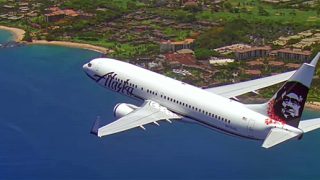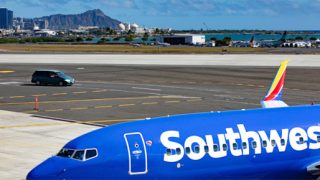Yesterday, Beat of Hawaii editors had a firsthand experience with an unexpected Hawaii flight incident that raised questions about what happens when a flight attendant suddenly becomes sick. While preparing to board a Southwest Airlines flight from Maui to Kauai, an unexpected halt occurred, drawing the attention of stunned passengers and ground staff. The incident also yielded insight for travelers, even experienced ones.
Incident Overview on Southwest Hawaii flight.
As boarding was about to commence, an ambulance suddenly appeared near the plane. Four medics entered the aircraft (some pictured in our lead photo), where only the crew was present. It was announced that there was a medical emergency in which a flight attendant was unwell, and an assessment would be conducted to determine their ability to continue working the flight.
This situation posed multiple significant challenges.
Southwest’s Boeing 737 MAX 8, which holds 175 passengers, requires four flight attendants to operate regardless of the actual passenger load. Unlike Hawaiian Airlines, Southwest Airlines does not maintain a substantial crew presence in the islands. Instead, they rotate staff through the islands for very brief periods before they return to the mainland. That begged the obvious concern.
The crew conundrum and time-outs.
Upon inquiring, it became clear that it was not known whether Southwest had an additional flight attendant available (not timed out) who was on Maui. Flight attendant “time out” refers to mandatory rest periods to ensure flight attendants are adequately fit for duty. These rest periods are regulated to maintain safe and efficient operations.
Without a replacement attendant available, the flight would likely have been canceled. This would have caused significant disruption to passengers and the airline, particularly since it was nearing 5 p.m., leaving Southwest with limited options to accommodate passengers traveling to Kauai. Passengers would have had to either arrange alternative travel plans or stay overnight on Maui.
Not only that, but flight attendants are not paid when the flight doesn’t operate. So, the remaining flight attendants on a canceled flight would not have been paid for yesterday’s situation. When I inquired with one of them, they were very happy to have been able to fly and to get paid.
Alternative arrangements came to mind quickly.
During this tense period, editor Jeff quickly explored alternatives on the Hawaiian Airlines website. He found two available seats on a later flight from Maui to Kauai, departing at 7 PM and arriving at 9 PM, via Honolulu. These tickets, totaling $377, were refundable, which provided some reassurance given the uncertain situation with Southwest.
Resolution and outcome of the situation.
Fortunately, Southwest managed to handle the situation effectively and it appears that the flight attendant was not seriously ill. The flight attendant’s condition was deemed stable enough for the flight to proceed with them on board, and the plane eventually departed for Kauai. This was also crucial since the aircraft was scheduled to overnight on Kauai and was needed for an early flight the following day.
During the flight, the affected flight attendant was observed in the aisle, working primarily with passengers seated at the back of the plane, suggesting perhaps a precautionary approach to ensure their well-being.
Another Hawaii flight crew incident occurred just two weeks ago.
This isn’t an isolated case. For instance, Alaska Airlines had to cancel a flight from Honolulu when crew members fell ill, highlighting how medical emergencies can impact flight operations. These situations emphasize the importance of having robust protocols and backup plans to ensure passenger safety and minimize travel disruptions.
Alaska Airlines had the issue in June when two flight attendants preparing to fly from Honolulu to Anchorage reported feeling unwell. In that case, it wasn’t due to illness but rather to what was described as a strange odor at the rear of the aircraft. With those flight attendants unable to work, the aircraft no longer had adequate crew members to continue operating and the flight was canceled.
What we learned yesterday.
This incident underscores the complexities airlines face when a crew member falls ill, especially on routes with limited backup options. Airlines like Southwest, which operate with leaner staffing models in the Hawaiian Islands, must have contingency plans to address such scenarios without causing major disruptions to passengers.
While Southwest successfully managed the situation this time, it served as a reminder for all airlines to review and improve their emergency protocols continually.
As passengers, too, we need to be alert and prepared for unexpected changes, ensuring that we know our options and rights in the case of possible flight disruptions.
Photo Credit – Beat of Hawaii. Emergency crew boarding Southwest yesterday.







On the night of July 5th, a Las Vegas bound Hawaiian airlines flight lost power, had to return to Honolulu airport after dumping fuel of md the Waianae coast abs had a heavy landing at HNL. How can I find out more about this aircraft and the incident?
It is Not true that the Southwest crew would not be paid for a cancelled flight due to one crew members illness. Where do you get your information from? Please verify before spreading false narratives.
Hi Sean.
First, rudeness will only get you banned here. That came directly from one of the flight attendants on this aircraft.
Aloha.
As a 30+ year Southwest captain who is married to a senior Southwest flight attendant I can assure you that the information was either misunderstood or she told a lie. The FAs would have gotten paid if the flight has been cancelled.
Flight attendants are paid for actual flight time, it is not a daily rate for showing up. Only our diem is paid after checking in for a trip.
Your information is incorrect regarding flight attendants getting paid. FAs are pay protected in the event of cancellation. Their contract states that they will get paid for what they are scheduled for or for what they actually fly whichever is greater.
These incidents are frequent according to my sister, a flight attendant. Often the incidents are related to noxious fumes in the cabin before passengers board. Airlines really don’t divulge more details than that. The unions are very aware of the incidents too. Guessing airlines don’t want people to panic so they keep it under wraps.
We have a trip to Maui planned for August which I almost cancelled when I read some comments made by residents. I have always respected the culture of any place I have visited especially Hawaii! I love the people and the beauty of the islands. We usually travel to Hawaii 2 to 3 times a year and I never tire of the location. We enjoy our hotel and the local restaurants. I will miss Lahaina and the Lahaina Yacht Club but my heart goes out to the residents of Lahaina for their unimaginable loss. I have made donations to several Hawaiian organizations in an effort to help in some small way!
All the negative things Hawaii is doing makes me feel ill and I’m not even on the plane yet!!!!! Go figure.